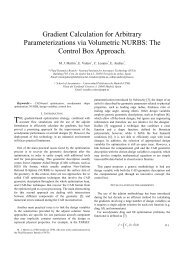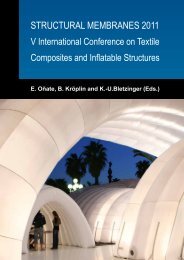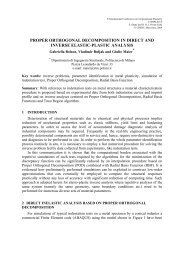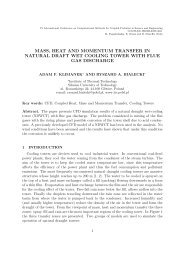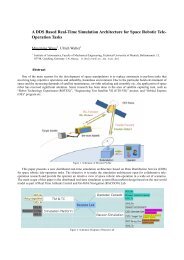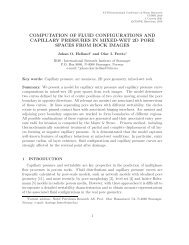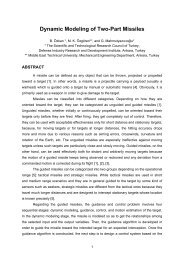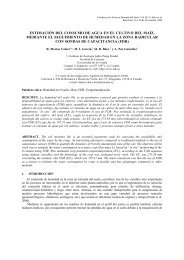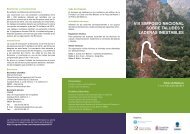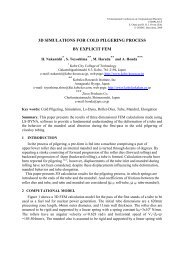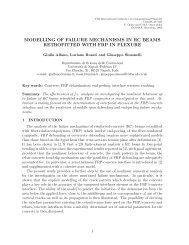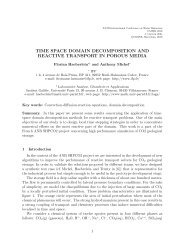Download - Congress.cimne.com
Download - Congress.cimne.com
Download - Congress.cimne.com
Create successful ePaper yourself
Turn your PDF publications into a flip-book with our unique Google optimized e-Paper software.
VIII International Conference on Computational Plasticity<br />
COMPLAS VIII<br />
E. Oñate and D. R. J. Owen (Eds)<br />
© CIMNE, Barcelona, 2005<br />
APPLICATIONS OF PHENOMENOLOGICAL FAILURE MODELS IN<br />
AUTOMOTIVE CRASH SIMULATIONS<br />
H. Werner * , H. Hooputra * , S. Weyer * , H. Gese †<br />
* BMW AG, Forschungs- und Innovationszentrum<br />
Knorrstrasse 147, D-80788 München, Germany<br />
e-mail: heinrich.werner@bmw.de, web page: http://www.bmwgroup.<strong>com</strong><br />
† MATFEM Partnerschaft Dr. Gese & Oberhofer<br />
Nederlingerstrasse 1, D-80638 München, Germany<br />
Email: helmut.gese@matfem.de - Web page: http://www.matfem.de<br />
Key words: Crash Simulation, Failure Model.<br />
1 INTRODUCTION<br />
In the automotive industry, an ongoing trend towards mixed material concepts in the body<br />
in white has been established. Components made of high- and ultra-high strength sheet steels,<br />
extruded and casted aluminium alloys, non-reinforced as well as reinforced thermoplastics,<br />
curable plastics like sheet moulding <strong>com</strong>pound (SMC) are an integral part of innovative<br />
design concepts, see Grünn et al. 1 . Therefore, crash simulations have to be able to describe the<br />
vastly different behaviour of these materials across the whole range of deformations − from<br />
elastic deformations up to more or less large deformations at failure. In addition, the<br />
mechanical behaviour of an increasing number of design materials is strongly influenced by<br />
the production process. Incorporating these effects in an industrially applicable manner to<br />
material models for crash simulations as well as modelling the behaviour of joints (spotwelds,<br />
linewelds, rivets, adhesive joints, etc.) is of primary importance for crash simulations.<br />
2 PHENOMENOLOGICAL FAILURE MODELLING<br />
The basis for a successful failure modelling is a correct simulation of macroscopic stresses<br />
and strains in a crash simulation. The main features of the material models used for metals<br />
and short-fibre reinforced or non-reinforced plastics are:<br />
• isotropic/orthotropic linear-elastic behaviour up to the onset of yielding<br />
• a stress state dependent criterion for the onset of yield (yield locus), see figure 1.<br />
• a strain rate dependent hardening rule<br />
• criteria for the onset of failure depending on the loading condition (stress triaxiality<br />
η and a parameter θ characterizing the shear loading, see table 1) and the material<br />
specific dependencies affecting the failure process (strain rate, orthotropy, porosity,<br />
fibre orientation, etc.). Three different mechanisms leading to failure are taken into<br />
consideration:<br />
o Plastic Instability leading to the formation of a neck in thin sheet metals<br />
loaded in the membrane plane. The onset of necking is immediately
H. Werner, H. Hooputra, S. Weyer, H. Gese.<br />
followed by fracture. Therefore, it can be utilized as a somewhat<br />
conservative failure criterion in structures discretized with shell elements.<br />
o Ductile fracture based on the growth, nucleation and coalescence of<br />
microvoids.<br />
o Shear fracture induced by a localization of shear bands.<br />
**<br />
As shown in table 1, the equivalent strain ε<br />
eq.<br />
is used to indicate the onset of failure for<br />
each criterion. The curves shown have to be interpreted as master-curves for an integral<br />
accumulation of damage, see Hooputra et al. 2 . Onset of instability is determined as a function<br />
of an arbitrary nonlinear strain path − resulting for example from a forming process<br />
simulation and a subsequent crash simulation − by means of a theoretical model incorporated<br />
in the algorithm CRACH. The phenomenological modelling of ductile fracture depends on<br />
stress triaxiality η . The parameters d<br />
0<br />
, d<br />
1<br />
and c of the function in the centre of table 1 are<br />
determined by suitably chosen experiments. Depending on the particular material, they may<br />
be a function of orientation (this is indicated in the figure in table 1), strain rate, fibre<br />
orientation, porosity distribution, etc. The latter case is presented in a <strong>com</strong>panion paper of<br />
Leppin et al. 3 . Shear fracture, depending on the parameter θ , is handled in an analogous way.<br />
To account for arbitrary nonlinear strain paths, a tensorial fracture criterion is used for ductile<br />
and shear fracture. Both fracture criteria are calculated separately, assuming no interaction<br />
between both fracture mechanisms. The IDS criteria are a <strong>com</strong>prehensive tool for predicting<br />
the onset of fracture initiation. A physically based crack propagation criterion in <strong>com</strong>bination<br />
with a numerically robust and discretisation independent formulation is a still missing link in<br />
the simulation process.<br />
3 APPLICATION OF IDS FAILURE MODEL TO AN AXIALLY COMPRESSED<br />
EXTRUSION COMPONENT<br />
The effectiveness of the failure criteria based on the evaluation of instability, ductile and<br />
shear fracture is demonstrated by <strong>com</strong>paring numerical results with test data of an axially<br />
<strong>com</strong>pressed double chamber extrusion <strong>com</strong>ponent, see figure 2. For static and dynamic<br />
impact conditions, the folding and fracture pattern from the test is in good agreement with the<br />
simulation results using the IDS failure criteria. The predominating fracture modes occurring<br />
in this test case are shear and ductile fracture. Shear fracture mainly occurs at the T-joint<br />
between the middle wall and the outer walls and at the corner of the wall segments of the<br />
double chamber profile. Ductile fracture occurs in the severely bent folds in the middle of the<br />
wall.<br />
4 APPLICATION OF IDS FAILURE MODEL TO THE IMPACT OF A<br />
SPHERICAL IMPACTOR ONTO A RIBBED THERMOPLASTIC PLATE<br />
A spherical impactor hitting the cover plate of a ribbed structure induces axial <strong>com</strong>pression<br />
followed by bending and finally fracture of the ribs. As shown in figure 3 (left), the fracture<br />
initiates at rib intersections approximately at half height of the ribs. In the centre of figure 3<br />
2
H. Werner, H. Hooputra, S. Weyer, H. Gese.<br />
this characteristic feature is well reproduced by a simulation using the improved yield locus in<br />
<strong>com</strong>bination with the ductile and shear failure criterion. On the other hand, the von Mises<br />
yield locus predicts the onset of fracture at the lower end of the ribs, see upper graph in the<br />
centre of figure 3. A further benefit of the improved yield locus is seen in figure 3 (right). The<br />
force displacement curve is closer to the experiment.<br />
a)<br />
b)<br />
Figure 1: a) Left: Strain hardening for an Aluminium alloy as a function of strain rate. a) Right: Yield loci used<br />
for metals. b) Left : Strain hardening for a non-reinforced thermoplast as a function of stress state. b)<br />
Right : Yield locus for a non-reinforced thermoplast for two equivalent strains.<br />
Static test Static simulation Dynamic test Dynamic simulation<br />
Figure 2 : Experimental and simulated deformation and fracture patterns of an axially <strong>com</strong>pressed<br />
extruded profile.<br />
3
H. Werner, H. Hooputra, S. Weyer, H. Gese.<br />
Figure 3 : Left: Experimental failure pattern of a ribbed plate impacted by a sphere. Centre: Simulation<br />
results of crack initiation site marked by red elements. Right: Comparison of force vs. displacement curves.<br />
Instability Ductile fracture Shear fracture<br />
ε<br />
⎛<br />
⎜ pl.<br />
⎜<br />
dε<br />
II<br />
= g<br />
pl.<br />
⎜ dε<br />
I<br />
123<br />
⎝ α<br />
**<br />
eq. ,<br />
I<br />
& ε<br />
pl.<br />
eq.<br />
⎞<br />
⎟<br />
⎟<br />
⎟<br />
⎠<br />
η =<br />
( − cη<br />
) d exp( cη<br />
)<br />
**<br />
ε<br />
.<br />
= d0<br />
exp +<br />
1<br />
eq<br />
D<br />
2<br />
2<br />
( σ −σ<br />
) + ( σ −σ<br />
) + ( σ −σ<br />
)<br />
1<br />
2<br />
σ + σ + σ<br />
1<br />
2<br />
2<br />
1<br />
1444444<br />
2444444<br />
3<br />
2<br />
3<br />
3<br />
3<br />
( − fθ<br />
) d exp( fθ<br />
)<br />
**<br />
ε<br />
.<br />
= d2<br />
exp +<br />
3<br />
eq<br />
S<br />
σ<br />
eq.<br />
θ = 1− k<br />
τ<br />
max<br />
( η)<br />
s<br />
σ eq .<br />
Table 1 : Overview of the IDS failure criteria. Symbols indicate experimentally determined sampling<br />
points, used to fit the parameters.<br />
REFERENCES<br />
[1] R. Grünn, J. Schönberger, G. Kettner, R. Zeller, O. Schreyer, J. Korzonnek, The new BMW 6-<br />
Series: The Art of Body Building − Intelligent and Innovative, ATZ MTZ extra, May 2004, pp.<br />
16−20.<br />
[2] H. Hooputra, H. Gese, H. Dell, H. Werner, A <strong>com</strong>prehensive failure model for crashworthiness<br />
simulation of aluminium extrusions, Int. J. of Crashworthiness, Vol. 9, No. 5, 2004, pp. 449−463.<br />
[3] C. Leppin, H. Hooputra, H. Werner, S. Weyer, R.V. Büchi, Crashworthiness simulation of<br />
aluminium pressure die castings including fracture prediction, VIII International Conference on<br />
Computational Plasticity, COMPLAS VIII, Barcelona, 5-8 September 2005.<br />
4




